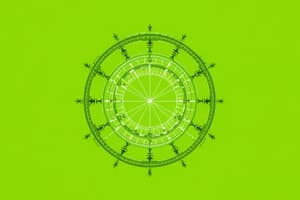Podcast
Questions and Answers
During a lunar eclipse, the shadow cast by the Earth is
During a lunar eclipse, the shadow cast by the Earth is
- Hexagonal
- Circular (correct)
- Triangular
- Rectangular
What did Eratosthenes do to calculate the Earth's circumference?
What did Eratosthenes do to calculate the Earth's circumference?
- Observed the length of a day and night
- Measured the angle of the sun's rays at two different locations (correct)
- Calculated the distance between the Earth and the Moon
- Counted the number of stars in the sky
What is precession?
What is precession?
- The law that states planets orbit the Sun in elliptical paths
- The apparent annual motion of stars and celestial bodies across the sky due to the Earth's revolution
- A gradual shift in the sky's trajectory caused by the Moon and Sun's gravitational force (correct)
- The apparent daily travel of stars across the sky caused by the Earth's rotation
Flashcards are hidden until you start studying
Study Notes
Ancient Astronomy and the Nature of Light
- The Greeks inferred that the Earth is spherical due to the circular shadow it casts during a lunar eclipse and their ability to calculate the size of the Earth's circumference.
- Eratosthenes calculated the Earth's circumference by measuring the angle of the sun's rays at two locations with different shadow lengths.
- The Greeks observed different views of the stars depending on whether they traveled north or south.
- Ancient civilizations accurately tracked astronomical events such as the length of a year, solar eclipses, and Venus's orbit around the Sun.
- Diurnal motion is the apparent daily travel of stars across the sky caused by the Earth's rotation.
- The Greeks characterized "wandering stars" or planets as moving differently from fixed stars.
- Annual motion is the apparent annual motion of stars and celestial bodies across the sky due to the Earth's revolution.
- The zodiac and equinoxes are used to create horoscopes and mark the appropriate time for crop growth.
- Precession is a gradual shift in the sky's trajectory caused by the Moon and Sun's gravitational force.
- Kepler's laws of planetary motion state that planets orbit the Sun in elliptical paths, traverse equal areas in equal times, and the square of the orbital period is proportional to the cube of the semimajor axis of its orbit.
- Galileo's experiments showed that objects accelerate at the same rate regardless of mass and horizontal motion does not require force.
- The Law of Reflection states that the angle of incidence equals the angle of reflection, and normal separates incident and reflected rays into equal angles.
Studying That Suits You
Use AI to generate personalized quizzes and flashcards to suit your learning preferences.




